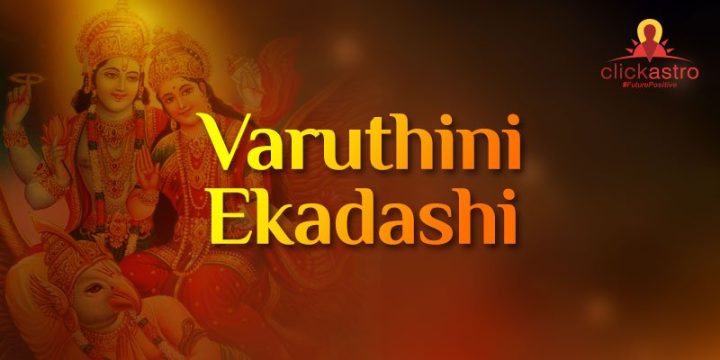Varuthini Ekadashi: Vrat that protects you from everything bad
The 11th tithi of a lunar phase is known as Ekadashi. Hindus, particularly Vaishnavites, regard it as sacred. On this day, Lord Vishnu is honoured. Devotees observe special pujas and vrat on this day. The Shukla Paksha Ekadashi and the Krishna Paksha Ekadashi are the two Ekadashis that occur each month. In a year, there are 24 Ekadashis. The Ekadashi that falls on the
Krishna Paksha of the Vaisakha month is known as
Varuthini Ekadashi.
The 2025 Varuthini Ekadashi falls on Thursday, April 24
What is Varuthini Ekadashi?
According to the North Indian Purnimant calendar, Varuthini also known as Baruthini Ekadashi is the Ekadashi (11th tithi) that occurs on the Krishna Paksha (waning phase) of the Vaisakha month. On the other hand, Varuthini Ekadashi, which falls on the Krishna Paksha of the Chaitra month, is the Ekadashi in the South Indian Amavasyant calendar. A month in the Purnimant calendar begins the day after the full moon and ends the day after the full moon. According to the Amavasyant calendar, the month begins on the day following the new moon and concludes on the day of the new moon. It is a sacred day for Hindus and is devoted to Lord Vishnu, particularly to his fifth avatar, Vamana. On this day, devotees perform pujas, vrat, and give alms.

Read about
Devutthana Ekadashi
The word “Varuthini” implies “protected.” The devotees who observe Varuthini Ekadashi are blessed with a spiritual shield that will guard them from all that is hurtful and bad. It is thought that by keeping vrat on this day and worshipping Vamana, the devotees will be blessed with good health, fortune, prosperity, pleasure, and fame, among other blessings. On this day, one who worships the Lord by remaining awake at night can atone for their sins and achieve moksha.
For the Vaishnava sects, ekadashis are particularly revered. Varuthini Ekadashi, according to the Vaishnava calendar, occurs on the Krishna Paksha of the Madhusudana month. Similar to the Purnimant calendar, the Vaishnava calendar begins a month on the day following a full moon and runs through the following full moon. The Baruthini Ekadashi is another name for the Vaishnava Varuthini Ekadashi. On this day, Lord Vamana is revered.
Read about
Parsva Ekadashi
Vamana was Lord Vishnu’s fifth and first human incarnation. He is occasionally referred to as the dwarf Avatar. Given that their mothers were the same, Indra, the ruler of the Devas, and Vamana are siblings. Vamana defeated the powerful Emperor Bali by begging for charity rather than using any weapons. The moral of the Vaman and Bali narrative is that you are given complete safety after you renounce yourself and your ego at the feet of Lord Vishnu, the supreme lord. The idea behind observing Varuthini Ekadashi is similar to this.
When is Varuthini Ekadashi 2023?
The 2025 Varuthini Ekadashi falls on Thursday, April 24.
Significant Muhurat Timings on Varuthini Ekadashi
| Sunrise |
April 24, 2025 6:02 AM |
| Sunset |
April 24, 2025 6:47 PM |
| Ekadashi Tithi Starts |
April 23, 2025 4:43 PM |
| Ekadashi Tithi Ends |
April 24, 2025 2:32 PM |
| Dwadashi End Time |
April 25, 2025 11:45 AM |
| Hari Vasara End Time |
April 24, 2025 7:50 PM |
| Parana Time |
April 25, 6:01 AM – April 25, 8:35 AM |
Varuthini Ekadashi Rituals
Certain rules are prescribed for observing Varuthini Ekadashi. One should observe a fast with an all-night vigil, praying and singing hymns. The Varuthini Ekadashi vrat may start on Dashami (10th lunar day), the day before the Ekadashi. On the day of Varuthini Ekadashi, the devotees should wake up early, take a holy bath and worship Lord Vishnu. It is an occasion meant for spiritual attainment, and so, the day should be spent chanting prayers or singing bhajans.
Full fasting without consuming any food or water is recommended for Varuthini Ekadashi vrat. Those who can’t afford this can observe a partial vrat by consuming fruits, nuts and water. The Varuthini Ekadashi vrat must only be broken the next day after offering prayers to Lord Vishnu.
The worship of Lord Vishnu or his avatar Vamana is an important Varuthini Ekadashi ritual. One can do this at home using lamps, incense sticks, Tulsi leaves, flowers, sandal paste etc. If possible, those who observe vrat must visit the temples of Lord Vishnu and stay awake, reciting mantras and reading scriptures. One may choose to read Satyanarayana katha, Vishnu Sahasranama or Bhagavad Gita chapters.
Varuthini Ekadashi Vrat
It is advised that followers of the Varuthini Ekadashi vrat fast from dawn on Ekadashi to dawn on Dwadashi. Although a full fast is advised, one can begin fasting at sunset the day before to make sure that no undigested food is still present in the stomach. Varuthini Ekadashi vrat involves more than merely giving up food. Gambling, lying, criticising others, violence, athletics, and sexual activity are all forbidden. The devout person on vrat shouldn’t give in to sleep, rage, or greed. Consequently, vrat purifies the mind, body, and soul by overcoming temptations and sensations. Varuthini Ekadashi also forbids certain practices like shaving and applying oil on one’s body.
The next day (Dwadashi), after sunrise, is appropriate to perform parana, or breaking the fast. In the event that Dwadashi does not end before sunrise, Parana must be performed the following day. Also, it is advised to avoid doing Parana in the first Dwadashi tithi quarter, which is the Hari Vasara time. While it is not advised to break the fast in Madhyahna, Pratahkal is thought to be the most fortunate moment to do so. A person should perform Parana after Madhyahna if they were unable to do it in Pratahkal.
Two types of
Ekadashi Vrats are recommended; one for Smarthas, those with family, and the other for Sanyasis and Moksha seekers. While a one-day fast is recommended for Smarthas or normal devotees, alternate fasting or a two-day fast is suggested for Sanyasis and Moksha seekers.
Fasting
Although complete fasting on Varuthini Ekadashi is advised, people who are unable to do so owing to health reasons can observe a partial fast by only eating once, at midday or in the evening. In that situation, a devotee should refrain from eating or drinking anything that is not vegetarian, including meat, fish, eggs, grains, onions, peas, beans, black gram, spinach, betel nuts, paan, red lentils, honey, sesame seeds, mustard, asafoetida, cloves, fennel, cardamom, nutmeg, tulsi, tamarind, custard, salt, baking soda and baking powder.
Eating in bell metal utensils and eating from other houses are also prohibited. The devotee can choose to eat the Havishyanna food offered to Yajna on the previous day. It is said that even those who are not observing the vrat should avoid consuming grains, pulses, and non-vegetarian foods on Ekadashi.
Varuthini Ekadashi Fasting Procedure
- A complete fast is recommended. So, a devotee can start fasting from the previous day’s sunset to avoid any undigested food remaining in the stomach.
- On Ekadashi day, the devotee should wake up before sunrise, take a bath and worship Lord Vishnu.
- Visiting a Vishnu temple, chanting prayers, and reciting Vishnu Sahasranama or Bhagavad Gita will intensify the spiritual drive.
- Breaking the fast or Parana should be done on the next day (Dwadasi) after taking a bath and worshipping Lord Vishnu. It should be done in the Parana time, which varies with each Dwadasi.
- Parana or breaking the fast shouldn’t be done during Hari Vasara Period, the first quarter of Dwadashi.
- The most auspicious time for Parana is Pratahkal. If the devotee couldn’t do it during Pratahkal, then he/she should do it after Madhyahna.
The legend associated with Varuthini Ekadashi
There is a story associated with Varuthini Ekadashi vrat told by Lord Krishna to Arjun. It’s the story of King Mandhata who ruled the banks of river Narmada. He was a generous and priestly king. Once on an occasion, when the King was meditating in the forest, a bear attacked him. It bit his feet and dragged him. The King, following the sacred rules of TapasyaDharm, didn’t respond and endured that ordeal, praying to Lord Vishnu. Eventually, Lord came to his rescue, but by then, the bear had chewed the King’s leg. The Lord advised the king to get back to Mathura, worship his Varaha Avatar and observe the Varuthini Ekadashi Vrat. The king who followed this advice devotedly became free from his past sins and got his injured leg back to normal.
What is the significance of Varuthini Ekadashi?
The significance of Varuthini Ekadashi is narrated by Lord Krishna to Yudhishtira in the
Bhavishya Purana. He says that this Ekadashi can turn the unfortunate into the fortunate and release a soul from the cycle of birth and death. Observing this Ekadashi has helped the Ikshvaku King Dhundhumara to become free from the curse of Shiva and King Mandata to get enlightened. Also, according to various Hindu legends, observing fast on Varuthini Ekadashi is equivalent to one hundred Kanyadaans or donating gold at Kurukshetra on the day of a solar eclipse.
Thus, Varuthini Ekadashi is an important observance for Hindus, offering countless benefits. It is believed that one who observes Varuthini Ekadashi vrat will be protected from all the evils and bestowed with blessings from Lord Vamana. Also, it is supposed to bestow cures for illnesses and sufferings, fame, happiness, prosperity, material pleasure etc.
The ultimate power of Varuthini Ekadashi is granting of Moksha, freedom from the cycle of life and death. According to Hindu astrology, one who observes the vrat on this day will be freed from all sins and liberated from the cycle of re-birth.
Varuthini Ekadashi festival dates between 2025 & 2028
| Year |
Day |
Date |
| 2025 |
Thursday |
April 24th |
| 2026 |
Monday |
April 13th |
| 2027 |
Sunday |
May 2nd |
| 2028 |
Thursday |
April 20th |
 Read about Devutthana Ekadashi
The word “Varuthini” implies “protected.” The devotees who observe Varuthini Ekadashi are blessed with a spiritual shield that will guard them from all that is hurtful and bad. It is thought that by keeping vrat on this day and worshipping Vamana, the devotees will be blessed with good health, fortune, prosperity, pleasure, and fame, among other blessings. On this day, one who worships the Lord by remaining awake at night can atone for their sins and achieve moksha.
For the Vaishnava sects, ekadashis are particularly revered. Varuthini Ekadashi, according to the Vaishnava calendar, occurs on the Krishna Paksha of the Madhusudana month. Similar to the Purnimant calendar, the Vaishnava calendar begins a month on the day following a full moon and runs through the following full moon. The Baruthini Ekadashi is another name for the Vaishnava Varuthini Ekadashi. On this day, Lord Vamana is revered.
Read about Parsva Ekadashi
Vamana was Lord Vishnu’s fifth and first human incarnation. He is occasionally referred to as the dwarf Avatar. Given that their mothers were the same, Indra, the ruler of the Devas, and Vamana are siblings. Vamana defeated the powerful Emperor Bali by begging for charity rather than using any weapons. The moral of the Vaman and Bali narrative is that you are given complete safety after you renounce yourself and your ego at the feet of Lord Vishnu, the supreme lord. The idea behind observing Varuthini Ekadashi is similar to this.
Read about Devutthana Ekadashi
The word “Varuthini” implies “protected.” The devotees who observe Varuthini Ekadashi are blessed with a spiritual shield that will guard them from all that is hurtful and bad. It is thought that by keeping vrat on this day and worshipping Vamana, the devotees will be blessed with good health, fortune, prosperity, pleasure, and fame, among other blessings. On this day, one who worships the Lord by remaining awake at night can atone for their sins and achieve moksha.
For the Vaishnava sects, ekadashis are particularly revered. Varuthini Ekadashi, according to the Vaishnava calendar, occurs on the Krishna Paksha of the Madhusudana month. Similar to the Purnimant calendar, the Vaishnava calendar begins a month on the day following a full moon and runs through the following full moon. The Baruthini Ekadashi is another name for the Vaishnava Varuthini Ekadashi. On this day, Lord Vamana is revered.
Read about Parsva Ekadashi
Vamana was Lord Vishnu’s fifth and first human incarnation. He is occasionally referred to as the dwarf Avatar. Given that their mothers were the same, Indra, the ruler of the Devas, and Vamana are siblings. Vamana defeated the powerful Emperor Bali by begging for charity rather than using any weapons. The moral of the Vaman and Bali narrative is that you are given complete safety after you renounce yourself and your ego at the feet of Lord Vishnu, the supreme lord. The idea behind observing Varuthini Ekadashi is similar to this.









Really enjoyed this post.Really thank you! Keep writing. makaberzux